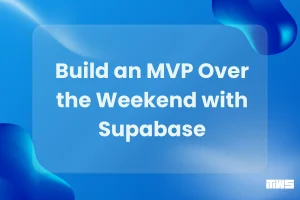In the race to build scalable digital products, the question is no longer whether to hire full-stack developers or specialists — but how to make both work together.
Early-stage startups often move fast with a few full-stack engineers. As the product matures, they bring in specialized roles: backend, frontend, DevOps, QA, and more. This transition is critical — and often painful.
Done right, hybrid teams combining full-stack developers and specialists deliver the best of both worlds: speed + structure, flexibility + depth.
In this article, we explore:
- Why hybrid team structures are becoming the norm
- How to make integration work in practice
- Pitfalls to avoid
- Real-world case studies from Team Work Spirit
Why Companies Start with Full-Stack Developers
Full-stack engineers are the go-to solution for building MVPs. According to the 2023 Stack Overflow Developer Survey, full-stack remains the most popular developer role worldwide.
Here’s why:
- Speed: One dev can design the UI, implement the backend, and deploy the code.
- Cost: Hiring one engineer to do the work of two or three lowers early burn.
- Ownership: Fewer handoffs mean tighter feedback loops and faster iteration.
At Team Work Spirit, we helped a US-based telemedicine startup build and launch an MVP in under 6 weeks using just 2 full-stack developers and a designer. They secured funding within 2 months of launch.
Why Specialized Teams Become Necessary
As products grow, new demands emerge:
- Real-time sync
- 99.99% uptime
- Role-based permissions
- HIPAA, SOC2, or PSD2 compliance
Full-stack developers, no matter how talented, eventually hit a ceiling.
That’s where specialized engineers come in:
- Backend developers bring architectural depth
- Frontend developers optimize complex UIs
- DevOps build observability, pipelines, and scaling infrastructure
- QA engineers automate testing across environments
This evolution — from a lean full-stack crew to a multidisciplinary team — is essential for scalability and product quality.
But integration is rarely plug-and-play.
The Integration Challenge
Merging generalists and specialists sounds good in theory. In practice, it often leads to:
- Overlapping Responsibilities
Who owns the API contract?
Should a full-stack dev work on UI now that there’s a frontend lead?
Who writes tests — full-stack or QA?
Without clear boundaries, teams fall into role confusion. - Friction Between Speed and Process
Full-stack engineers are used to moving fast. Specialists often demand:
More documentation
Structured sprints
Code review policies
This can cause frustration unless expectations are aligned. - Technical Debt and Standards Gaps
As new specialists join, they often discover:
Inconsistent codebases
Missing documentation
Lack of test coverage
If not addressed early, this leads to rewrites and friction.
5-Step Strategy to Integrate Full-Stack and Specialized Roles
To make this hybrid model work, you need intentional team design. Here’s how:
1. Define Clear Ownership Areas
Set tech boundaries between roles. For example:
| Component | Owner |
|---|---|
| API contracts | Backend team |
| UI components | Frontend team |
| Deploy pipelines | DevOps |
| Feature logic | Full-stack (if cross-cutting) |
Even better: visualize this in a RACI matrix so everyone knows who’s responsible, accountable, consulted, and informed.
2. Create Onboarding for Specialists (and Vice Versa)
Full-stack devs have tribal knowledge. Specialists bring structure and rigor. Bridge the gap through onboarding like:
- Codebase walkthroughs
- Architecture sessions
- Pair programming across roles
- Joint retrospectives on delivery pain points
A dedicated “integration sprint” where both types work together on a shared feature is a great onboarding tactic.
3. Establish Engineering Standards Together
Don’t let new rules come top-down from specialists. Instead:
- Involve full-stack devs in discussions on linting, testing, and branching
- Co-create CI/CD guidelines
- Agree on tools (e.g., Storybook for UI, Swagger for APIs, GitHub Actions for deployment)
This fosters collective ownership and prevents resentment.
See DevOps practices for scaling SaaS in our article: DevOps Best Practices for Scaling SaaS Platforms
4. Use Hybrid Delivery Squads
Avoid siloed departments. Instead, structure your team into feature squads like this:
- 1 full-stack dev (end-to-end glue)
- 1 frontend dev (UX performance)
- 1 backend dev (API depth)
- 1 QA (testing coverage)
- Shared DevOps across squads
This mix lets you ship fast, without sacrificing depth or quality.
5. Measure the Right Metrics
Full-stack developers often optimize for velocity. Specialists look at quality.
Define joint KPIs:
- Lead time to deploy
- Bug rate post-deploy
- Code review cycle time
- Unit + e2e test coverage
- Team satisfaction (DevEx surveys)
A good reference is the DORA metrics framework used by elite engineering orgs.
Real-World Use Case: Scaling a Fintech Platform
A European fintech client of Team Work Spirit started with a full-stack-only team. When they hit 100K+ users, issues emerged:
- Spaghetti code in payment logic
- Slow releases due to testing gaps
- AWS costs ballooned without proper infra management
We introduced:
- Specialized backend engineers (Node.js)
- Frontend team (React + Design System)
- DevOps (Terraform, AWS autoscaling)
- QA automation (Playwright)
Full-stack devs were retained and repositioned as feature leads, bridging UI and backend.
Results:
- 60% reduction in bugs
- 3x faster release cycles
- Infrastructure costs down by 35%
Explore more in our portfolio
Common Mistakes to Avoid
- Treating Full-Stack Devs as “Junior Generalists”
Experienced full-stack devs are systems thinkers. Don’t downgrade their role — give them architecture or cross-squad influence.
- Replacing Instead of Repositioning
Bringing in specialists doesn’t mean you need to offboard full-stack talent. Use them to:
- Lead vertical features
- Mentor junior devs
- Prototype new modules
- Lack of Communication Culture
Encourage:
- Weekly technical design reviews
- Cross-functional standups
- Shared retros and sprint planning
Hybrid teams fail not from structure — but from silence.
The Future is Hybrid
Companies like Netflix, Shopify, and Revolut now organize around cross-functional pods that include both generalists and specialists. This enables:
- Rapid experimentation
- Technical depth at scale
- Resilience to hiring market shifts
In fast-moving sectors like Fintech, HealthTech, and SaaS, hybrid teams aren’t just a trend — they’re a strategic advantage.
Final Thoughts
The full-stack vs. specialized debate is outdated. The real question is: how to design teams that combine the strengths of both.
At Team Work Spirit, we help tech companies across 10+ countries build scalable digital platforms — and the high-performing teams behind them.
Whether you’re:
- Moving from MVP to growth stage
- Rebuilding your delivery pipeline
- Expanding your engineering team
We’ll help you design the right hybrid setup for your product, culture, and roadmap.
Let’s Build the Right Team Together
- Learn more on our blog: https://www.twsgo.com/blog/
- Explore case studies: https://www.twsgo.com/portfolio
- 📞 Talk to us: https://www.twsgo.com/



